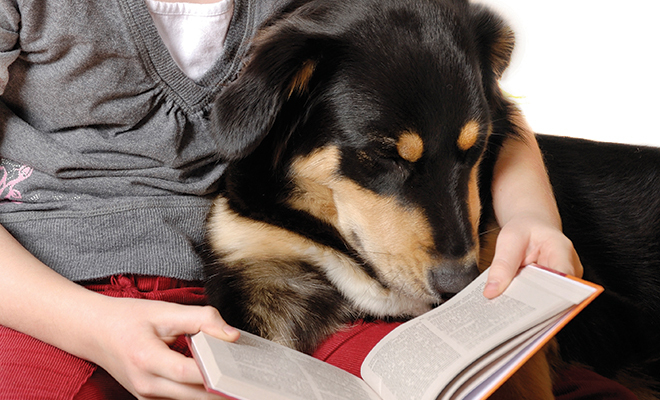
Reading Support From Four-legged Friends: Reading Education Assistance Dogs
Whether your child is a strong or a struggling reader, sometimes a little encouragement and support can come from not only an unexpected place, but in the form of a furry listener with four legs and a wagging tail.
Throughout history dogs have been used to help in just about every aspect of human life. They’ve been used as burglar alarms, spies, eyes, hands, cancer detectors and, of course, companions, just to name a few. Since 1999, they have also been officially used as reading companions.
Intermountain Therapy Animals began a literacy program with therapy dogs in Salt Lake City to assist children in becoming better readers and to encourage improvement in communication skills. Now, more than 15 years since its inception and with more than 3,000 teams of trained dogs and their owners, this world-wide organization is helping kids not just to read and communicate better, but also cultivate a love for books and the written word.
But becoming a reading therapy dog is more than just enlisting Fido to connect with kids while they read. Dogs and their owners must register with one of the therapy pet training programs such as Pet Partners or Therapy Dogs Inc. and undergo training through the Reading Education Assistance Dogs (R.E.A.D.®) program. The R.E.A.D. program improves children’s reading and communication skills by employing a powerful method–reading to an animal. R.E.A.D. companions are registered therapy animals who volunteer with their owner/handlers as a team, going to schools, libraries and many other settings as reading companions for children. Once the dog and owner get their paperwork approved, they can go into any number of venues as a registered R.E.A.D. team and enjoy the pleasure of opening the world of books to children. These trained teams can be found throughout the United States, Canada, Europe, South Africa, Scandinavia and other countries.
Why are reading therapy dogs important?
When you stop to consider that nearly 80 percent of people identified with learning disabilities are reading disabled, it’s encouraging to know that research shows that simply reading to a dog can help improve reading skills. Programs in libraries, schools and other institutions are helping kids of all abilities turn on to books as they read to a four-legged listener.
These reading therapy dogs are doing a lot to help children conquer their fear and/or embarrassment around their lack of reading abilities. Some children improve their reading levels by as much as three or four grade levels over time while participating in animal-assisted therapy with regular contact.
Children who have difficulty reading suffer in many ways and problems become compounded over time. Insufficient reading skills can have a major impact upon a person’s entire life, affecting all areas. It’s not just about reading books; illiteracy can mean an inability to deal with simple tasks such as directions for putting a toy together. These problems compound as the child enters adulthood and needs to do things such as study for a driver’s test, fill out a job application or read directions on a prescription.
Benefits of reading with a dog
It’s a fairly well-known fact that pets, especially dogs and cats, can have a calming effect on people, and studies have demonstrated that companion animals lower blood pressure and reduce stress. Research has also shown that increased blood pressure and high stress levels inhibit the learning process. When children read with a dog present, they tend to be calmer and more relaxed.
Michelle McCaughtry, R.E.A.D. program member and owner of a reading therapy dog named Lulu, had this to share about the benefits of four-legged reading buddies. “Most kids become motivated when they are reading to a dog,” she shared. “Our reading assistance dog Lulu is very patient and calm and likes to snuggle up to the young readers who visit her. If our young readers are physically touching Lulu as they read, they automatically relax and the words seemingly become clear and easy for them to read. We’ve also found that readers who are very shy and self-conscious about reading in front of others don’t feel that way when they read to Lulu. They know that Lulu will never judge, interrupt, criticize, laugh, correct them or hurry them along. She will just lie there and let them read; she’s a perfect listener.”
Breaking through the fear and angst of reading by reading to a canine companion can put a child on the road to a life-long love of books and open up a world of possibilities. The love of reading at a young age will help our children carry that love forward into adulthood, and good reading skills are critical for readers of any age. If a reading assistance dog can help someone get to that point of loving reading, it’s one more wonderful thing a dog can do.
Even more, it’s very rewarding for the human portion of the team. If you believe your canine companion would be suitable for this crucial job, don’t hesitate to find your local pet partner or therapy certifying group and get started!
Sources: nmu.edu, petpartners.org, therapyanimals.org and therapydogs.com.







